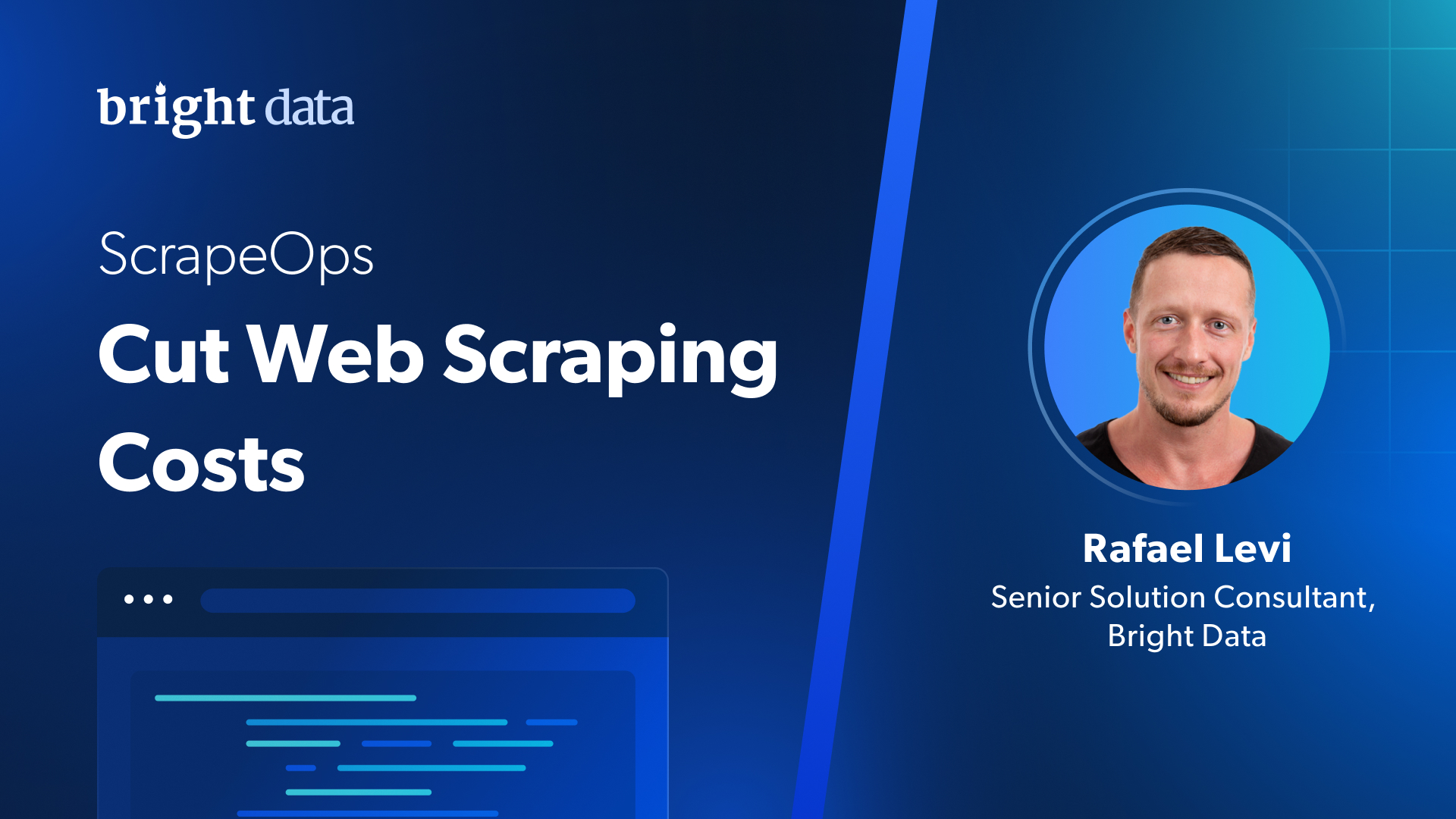Vamos Começar
Meu nome é Rafael Levy e sou consultor de soluções na Bright Data. Nos últimos seis anos, adquiri uma vasta experiência em coleta de dados. Em meu recente webinar, compartilhei informações valiosas sobre como otimizar os processos de coleta de dados e alcançar economias significativas. Aqui está um resumo dos principais pontos que discutimos para ajudar você a aprimorar suas estratégias de coleta de dados e aproveitar ao máximo seus recursos.
Atualmente, a coleta eficiente de dados é mais crucial do que nunca. No entanto, ela vem com seu próprio conjunto de desafios. Os sites estão implementando mecanismos sofisticados de bloqueio de bots, dificultando o acesso aos dados necessários. Além disso, os custos associados à coleta de dados podem aumentar rapidamente, especialmente se você não estiver utilizando os métodos e proxies mais eficientes.
Diferentes Métodos de Coleta de Dados
Quando se trata de coletar dados, há várias abordagens que você pode adotar, cada uma com seus próprios conjuntos de vantagens e desvantagens. Vamos explorar esses métodos:
1. Coleta de Dados Interna
- Prós: Controle total sobre o processo, personalização para atender necessidades específicas.
- Contras: Requer recursos significativos, incluindo desenvolvedores, servidores e infraestrutura. Isso pode ser particularmente desafiador se a coleta de dados não for seu negócio principal.
- Quando Usar: Mais adequado para organizações com uma equipe dedicada e recursos para gerenciar tarefas complexas de coleta de dados.
2. Coleta de Dados Híbrida
- Prós: Combina os benefícios do controle interno com a eficiência dos serviços de terceiros. Por exemplo, usar o serviço do desbloqueador da Bright Data pode ajudar a contornar mecanismos complexos de bloqueio de bots sem a necessidade de um desenvolvimento interno extensivo.
- Contras: Ainda requer alguns recursos internos, mas significativamente menos do que uma abordagem totalmente interna.
- Quando Usar: Ideal para organizações que desejam manter algum controle enquanto aproveitam a experiência de terceiros para tarefas específicas.
3. Data as a Service (DaaS)
- Prós: Terceiriza todo o processo de coleta de dados, permitindo que você se concentre em analisar e utilizar os dados em vez de coletá-los. Isso pode gerar economias significativas.
- Contras: Menos controle sobre o processo de coleta de dados e possível dependência do provedor de serviços.
- Quando Usar: Ideal para organizações cujo negócio principal envolve analisar dados em vez de coletá-los. É uma solução econômica para quem precisa de dados confiáveis sem a sobrecarga de gerenciar o processo de coleta.
Compreendendo esses métodos, você pode escolher o que melhor se adapta às necessidades e recursos de sua organização, garantindo um processo de coleta de dados mais eficiente e econômico.
A Importância dos Proxies na Coleta de Dados
Os proxies desempenham um papel fundamental na coleta de dados, funcionando como intermediários entre suas ferramentas de coleta e os sites de destino. Compreender os diferentes tipos de proxies e como usá-los de forma eficaz pode impactar drasticamente sua taxa de sucesso e eficiência de custos.
Tipos de Proxies:
- Proxies de Datacenter: São os proxies mais econômicos, mas também os mais propensos a serem bloqueados por sites devido ao seu alto uso por raspagem de dados.
- Proxies Residenciais: Usam endereços IP fornecidos por Provedores de Serviços de Internet (ISPs) aos proprietários. Eles têm menos probabilidade de serem bloqueados, mas são mais caros.
- Proxies Móveis: São os mais caros e utilizam endereços IP fornecidos por operadoras de telefonia móvel. Eles são os menos propensos a serem bloqueados.
Escolha do Tipo de Proxy Adequado: A seleção do tipo de proxy apropriado depende dos requisitos específicos de sua tarefa de coleta de dados. Enquanto os proxies residenciais e móveis são menos propensos a serem bloqueados, os proxies de datacenter podem ser econômicos quando usados corretamente.
Implicações de Custos e Estratégias de Otimização: Usar proxies de datacenter de forma eficaz pode resultar em economias significativas. Por exemplo, adicionando cabeçalhos e cookies apropriados, você pode aumentar a taxa de sucesso dos proxies de datacenter, reduzindo a necessidade de proxies residenciais mais caros. Ferramentas de automação de navegador, como Puppeteer e Selenium, também podem aumentar a eficácia dos proxies de datacenter ao simular o comportamento humano.
Técnicas de Economia com IPs de Datacenter
Um dos maiores equívocos na coleta de dados é a necessidade de usar IPs residenciais para todas as tarefas. Embora os IPs residenciais tenham suas vantagens, os IPs de datacenter podem ser uma alternativa econômica, se usados corretamente. Aqui estão algumas técnicas para maximizar a eficácia dos IPs de datacenter:
1. Uso de Cabeçalhos e Cookies: Ao imitar o comportamento de um navegador padrão, você pode aumentar significativamente a taxa de sucesso dos IPs de datacenter. Adicionar cabeçalhos e cookies às suas solicitações pode fazê-las parecer mais legítimas, reduzindo as chances de serem bloqueadas. Por exemplo, ao fazer raspagem na Amazon, adicionar cabeçalhos e cookies apropriados pode melhorar a taxa de sucesso de 10% para quase 100%.
2. Automação do Navegador: Ferramentas como o Puppeteer e o Selenium podem aumentar ainda mais a taxa de sucesso dos IPs de datacenter. Ao usar essas ferramentas, você pode automatizar ações no navegador para simular o comportamento humano, o que ajuda a contornar sistemas de detecção de bots. Esse método é particularmente útil para sites com medidas anti-bots mais sofisticadas.
3. Bloqueio de Solicitações Desnecessárias: Outra técnica eficaz é bloquear solicitações desnecessárias, como imagens e scripts, o que pode economizar banda larga e reduzir custos. Ao carregar apenas os elementos essenciais necessários para sua coleta de dados, você pode melhorar a eficiência e reduzir as despesas. Por exemplo, bloquear solicitações de imagens na Amazon pode reduzir o uso de banda larga em mais de 50%.
Técnicas Avançadas para Coleta de Dados
Otimizar seu processo de coleta de dados vai além de apenas escolher os proxies adequados. Aqui estão algumas técnicas avançadas para melhorar ainda mais sua eficiência e custo-benefício:
1. Bloqueio de Solicitações Desnecessárias: Conforme mencionado anteriormente, o bloqueio de solicitações não essenciais, como imagens, arquivos CSS e scripts de terceiros, pode economizar uma quantidade significativa de banda larga. Ferramentas como o Chrome DevTools permitem que você experimente bloquear vários tipos de solicitações para ver o que pode ser omitido com segurança sem interromper o site. Implementar esses bloqueios nos seus scripts pode levar a grandes economias.
2. Automação de Extração de Cabeçalhos e Cookies: Configurar manualmente cabeçalhos e cookies pode ser trabalhoso. Automatizar esse processo pode garantir que você sempre tenha as configurações mais recentes e eficazes. Use a automação do navegador para ir até o site, capturar os cabeçalhos e cookies necessários e, em seguida, aplicá-los às suas solicitações de coleta de dados.
3. Caminho Mais Curto para Coleta de Dados: A eficiência na coleta de dados muitas vezes depende do número de etapas necessárias para obter os dados. Sempre tente usar o caminho mais curto. Por exemplo, se você precisar coletar avaliações de um site de comércio eletrônico, crie URLs diretos para as páginas de avaliação em vez de navegar por várias páginas. Isso reduz os tempos de carregamento e o uso de banda larga.
4. Métodos de Mistura e Combinação: Às vezes, uma abordagem híbrida é a mais eficaz. Por exemplo, use um navegador para realizar a autenticação inicial e capturar tokens, em seguida, mude para solicitações de API para posterior coleta de dados. Isso combina os pontos fortes de ambos os métodos, garantindo maiores taxas de sucesso e eficiência.
Personalização de Planos de Serviço para Eficiência de Custos
Otimizar seu processo de coleta de dados não se trata apenas de métodos técnicos, também envolve escolher os planos de serviço e modelos de preços adequados. Veja como você pode ter certeza de que está obtendo o melhor custo-benefício:
1. Escolher o Modelo de Preço Adequado: Diferentes provedores de proxy oferecem vários modelos de preços, como planos baseados em banda larga ou número de solicitações. Por exemplo, se suas tarefas de coleta de dados envolvem carregar grandes quantidades de dados, um plano baseado em solicitações pode ser mais econômico. Por outro lado, se você estiver fazendo muitas solicitações com pequenos volumes de dados, um plano baseado em banda larga pode ser melhor. Analise seus padrões de uso para escolher o plano mais adequado.
2. Planos Mensais e Anuais: Comprometer-se com um plano mensal ou anual pode oferecer descontos significativos em comparação com as opções de pagamento conforme o uso. Esses planos reduzem o custo por unidade (seja por gigabyte ou por solicitação) e proporcionam despesas mais previsíveis. Comece com um compromisso menor, se for cauteloso, e aumente gradualmente à medida que se tornar mais confiante em suas necessidades.
3. Compromissos e Negociações de Volume: Consolidar seu tráfego com um provedor e se comprometer com volumes maiores pode desbloquear melhores níveis de preços. Por exemplo, em vez de dividir seu tráfego entre vários provedores, concentrar todo o tráfego para um único provedor, como a Bright Data, pode resultar em descontos substanciais. Negocie com seu provedor para obter as melhores tarifas para seu volume.
4. Exemplo de Estudo de Caso: Tivemos um cliente que dividiu seu tráfego 50/50 entre nós e outro provedor, gastando um total de US$ 31.000 por mês. Ao consolidar 90% de seu tráfego conosco, seu custo total caiu para US$ 24.000 por mês, resultando em uma economia anual de US$ 84.000. Esse exemplo ressalta os benefícios financeiros da consolidação de volumes e do planejamento estratégico.
Ao selecionar e personalizar cuidadosamente seus planos de serviço, você pode reduzir significativamente seus custos de coleta de dados e alocar recursos com mais eficiência.
Destaques de Perguntas e Respostas
Durante o webinar, abordamos várias perguntas esclarecedoras do público. Aqui estão algumas das principais conclusões:
1. Selecionar o Que Baixar: Um participante perguntou se é possível selecionar elementos específicos para baixar em vez de bloquear tudo. Embora você possa bloquear recursos desnecessários, como imagens e scripts de terceiros, tentar baixar seletivamente apenas alguns elementos pode ser complicado e resultar na interrupção do site. Uma abordagem mais eficaz é bloquear categorias amplas, como imagens ou scripts, e ajustar com base no que o site precisa para funcionar corretamente.
2. Migração do Código do Puppeteer: Outra pergunta foi sobre a migração do código do Puppeteer para o Desbloqueador de Web em Nuvem da Bright Data. O desbloqueador é mais adequado para coleta de dados baseada em API do que para automação de navegador. No entanto, nosso navegador de raspagem pode executar scripts do Puppeteer em nossos servidores, oferecendo todos os benefícios da automação do navegador sem a necessidade de manter sua própria infraestrutura.
3. Recursos Adicionais para Aprender: Para quem é iniciante em raspagem de dados, recomendo aprender seletores de CSS e escolher uma linguagem como Python para suas bibliotecas robustas, como Beautiful Soup e Selenium. Essas ferramentas são essenciais para uma análise eficaz de dados e automação do navegador.
4. Automação de Cabeçalhos e Cookies: Extrair cabeçalhos e cookies manualmente pode ser trabalhoso, portanto, automatizar esse processo é benéfico. Use a automação do navegador para carregar as páginas necessárias, capturar os cabeçalhos e os cookies e aplicá-los às suas tarefas de raspagem. Isso garante que você esteja sempre usando as configurações mais atualizadas.
Conclusão – O Que Você Realmente Precisa Saber
Para resumir, otimizar seu processo de coleta de dados envolve uma combinação de selecionar os métodos adequados, aproveitar estratégias de proxy eficazes e empregar técnicas avançadas para maximizar a eficiência e a economia de custos. Ao entender os prós e os contras das abordagens internas, híbridas e de DaaS, você pode escolher a melhor opção para suas necessidades. Além disso, empregar técnicas de economia com IPs de datacenter, bloquear solicitações desnecessárias e personalizar planos de serviço são etapas cruciais para alcançar economias substanciais.
Espero que as percepções compartilhadas neste webinar, juntamente com as respostas às suas perguntas, ofereçam orientações valiosas para seus esforços em coleta de dados. A implementação dessas estratégias pode ajudar a otimizar seus processos, reduzir custos e, finalmente, aumentar o sucesso de seus projetos de coleta de dados.














